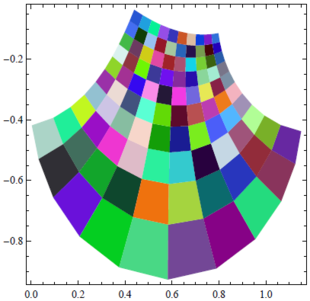|
|
| Line 21: |
Line 21: |
|
1 & 0 \\ |
|
1 & 0 \\ |
|
\end{pmatrix} |
|
\end{pmatrix} |
|
</math>. |
|
</math> be matrices. |
|
|
|
| ⚫ |
We want to equate <math>span(M_1, M_2, M_3)</math> to the set of all symmetric <math>2 \times 2</math> matrices. |
|
|
|
|
|
⚫ |
We want to equate <math>span(M_1, M_2, M_3)</math> to the set of all symmetric <math>2 \times 2</math> matrices. Here is the wrong way to write this: |
|
|
|
|
|
Here is the wrong way to do it: |
|
|
|
|
|
|
<math> |
|
<math> |
| Line 34: |
Line 35: |
|
</math>. |
|
</math>. |
|
|
|
|
| ⚫ |
Firstly, <math>span(M_1, M_2, M_2)</math> is tje set of all linear combinations of <math>M_1, M_2, M_3</math>. To equate it to a single symmetric <math>2 \times 2</math> matrix makes no sense. Secondly, the elements <math>a, b, c, d</math> are undefined. What are they suppose to represent? Rational numbers? Real numbers? Members of the field of two elements? |
|
|
|
|
|
|
⚫ |
Firstly, <math>span(M_1, M_2, M_2)</math> is the set of all linear combinations of <math>M_1, M_2, M_3</math>. To equate it to a single symmetric <math>2 \times 2</math> matrix makes no sense. Secondly, the elements <math>a, b, c, d</math> are undefined. What are they suppose to represent? Rational numbers? Real numbers? Members of the field of two elements? The following way of writing erases those issues. |
|
|
|
|
|
Here is a better way to do it: |
|
|
|
|
|
|
<math> |
|
<math> |
Revision as of 17:59, 14 October 2014
Welcome to Math 240!
(additions to this web site no longer count towards good deed points)
|
| #
|
Week of...
|
Notes and Links
|
| 1
|
Sep 8
|
About This Class, What is this class about? (PDF, HTML), Monday, Wednesday
|
| 2
|
Sep 15
|
HW1, Monday, Wednesday, TheComplexField.pdf,HW1_solutions.pdf
|
| 3
|
Sep 22
|
HW2, Class Photo, Monday, Wednesday, HW2_solutions.pdf
|
| 4
|
Sep 29
|
HW3, Wednesday, Tutorial, HW3_solutions.pdf
|
| 5
|
Oct 6
|
HW4, Monday, Wednesday, Tutorial, HW4_solutions.pdf
|
| 6
|
Oct 13
|
No Monday class (Thanksgiving), Wednesday, Tutorial
|
| 7
|
Oct 20
|
HW5, Term Test at tutorials on Tuesday, Wednesday
|
| 8
|
Oct 27
|
HW6, Monday, Why LinAlg?, Wednesday, Tutorial
|
| 9
|
Nov 3
|
Monday is the last day to drop this class, HW7, Monday, Wednesday, Tutorial
|
| 10
|
Nov 10
|
HW8, Monday, Tutorial
|
| 11
|
Nov 17
|
Monday-Tuesday is UofT November break
|
| 12
|
Nov 24
|
HW9
|
| 13
|
Dec 1
|
Wednesday is a "makeup Monday"! End-of-Course Schedule, Tutorial
|
| F
|
Dec 8
|
The Final Exam
|
| Register of Good Deeds
|

Add your name / see who's in!
|

|
|
Boris
Elementary and (Not So Elementary) Errors in Homework
(1) Let  be matrices.
be matrices.
We want to equate  to the set of all symmetric
to the set of all symmetric  matrices. Here is the wrong way to write this:
matrices. Here is the wrong way to write this:
 .
.
Firstly,  is the set of all linear combinations of
is the set of all linear combinations of  . To equate it to a single symmetric
. To equate it to a single symmetric  matrix makes no sense. Secondly, the elements
matrix makes no sense. Secondly, the elements  are undefined. What are they suppose to represent? Rational numbers? Real numbers? Members of the field of two elements? The following way of writing erases those issues.
are undefined. What are they suppose to represent? Rational numbers? Real numbers? Members of the field of two elements? The following way of writing erases those issues.
 where
where  is an arbitrary field.
is an arbitrary field.
Nikita










